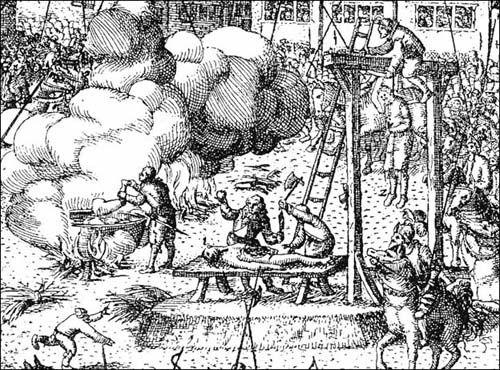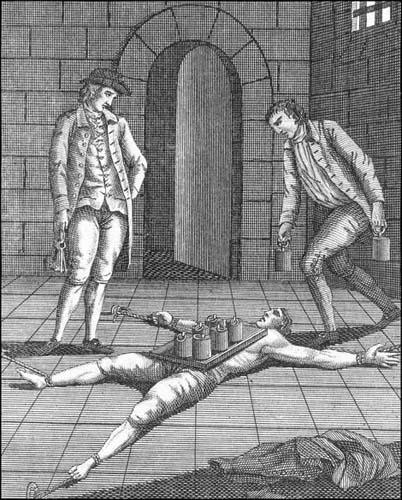The Big Book of Pain: Torture & Punishment Through History (13 page)
Read The Big Book of Pain: Torture & Punishment Through History Online
Authors: Daniel Diehl


Here we see an image of three poor souls being hanged, drawn and quartered. On the right we see the hanging (though he will be cut down while still alive), then the drawing out of the entrails, evisceration and castration is shown center. This would be followed by decapitation and then the ‘quartering’ of the body into segments which would be boiled in tar for preservation (shown left) to be displayed in different parts of the kingdom as a warning to others. Note how the executioner with the knife holds up the heart of the victim for the approval and satisfaction of the assembled crowd.
Known as
peine forte et dure
(long-lasting, intense pain) this new approach to juris prudence was not only like Edward himself – strong and hard – but became the standard, judicial operating procedure for the next three centuries. It must be understood that such measures were not considered torture. Torture was technically illegal in England under the terms of Magna Charta. Being chained to a dungeon floor, fed garbage and slowly pressed to death was just a method of convincing a person to make a plea – after all, if a person was innocent, why would they hesitate to plead their case? For all his harsh treatment of accused felons, Edward was truly and deeply concerned with the corruption permeating the English court system. The main charge levied against local judges was that they arrested innocent men, threw them into prison and only released them after they had paid an exorbitant fine. It was a natural outgrowth of the eminently profitable outlawry system. When witnesses could not be found to support the system’s pre-determined verdicts, totally uninvolved people were dragged off the streets and tortured until they offered evidence against innocent people and complete strangers. Juries were ‘packed’ with friends of the judges and sheriffs who shared in the ill-gotten booty of rigged trials. The predictable result of such corruption was that virtually no one had the least respect for either the law or those who enforced it; when juries were not coerced into bringing in the verdict, which the judge or sheriff wanted, they routinely let guilty men go free simply because they hated the system more than they hated the criminals. Furious that his kingdom had become so debased, Edward threw out everyone accused of bribe-taking, coercion, blackmail and influence peddling and replaced them only to find that after a few years the new officials had become just as corrupt as the old ones.

This image shows the process of pressing (
peine forte et dure
) but does little to convey the true agony of the experience. The victim here seems almost relaxed. But in reality as more and more weight is added it becomes increasingly difficult to breathe. Eventually the ribcage will collapse and the lungs will be compressed resulting in slow suffocation.
There were places, outside England, where the system ran more efficiently; if not the judicial system itself, then at least the mechanism for dealing with lawbreakers. In twelfth-century Russia anyone tortured without the specific approval of the local prince was allowed redress for his pain and was even able to sue for compensation; the moral being that if you wanted to torture someone you had to go through proper channels first. By 1300, those mechanical innovators, the Germans, had invented a machine capable of lopping off a criminal’s head with frightening efficiency. What this guillotine-like device looked like is unknown, but in its first year it was used to cleanly, swiftly and bloodily do away with five men in the town of Zittau. Naples, in Italy may have used such a device slightly earlier, and only seven years later a similar machine was in use in Ireland. It did not take long for the English to catch on and by the middle of the 1300s a beheading machine was in constant use in the Yorkshire town of Halifax. There, on market days, the excitement of buying, selling and general merrymaking was added to by the steady chop, chop, chop of the Halifax gibbet.


Here we find two illustrations of early medieval beheading machines sometimes known as ‘fallbrett’ (or falling board). These ancestors of the guillotine were slow and gruesome affairs which took a distant third to the guillotine or the headsman’s axe in terms of efficiency. As the ‘board’ would frequently chew slowly through the victim’s neck, it was hoped that the first hit might paralyze the condemned to keep them still throughout the process.
We know that as late as the mid-sixteenth century, the Halifax gibbet was still in use because in 1565 the Earl of Morton, regent of Scotland, watched it at work and was impressed enough with its efficiency that he carried the idea back across the border with him and had a similar device built in Scotland. Adding a novel twist to what could well have become stale entertainment, if a man stole a farm animal the object of his heist was used to haul in the rope attached to the Halifax gibbet’s blade. When the axe, or blade, was drawn to the proper height, the rope was released and thus even God’s lesser creatures could extract vengeance on their abductors. Occasionally, however, animals wound up on the wrong end of the rope. Literally. Throughout Europe, if an animal attacked a human it could be tried and, if found guilty, duly executed for its ‘crime’. In France, in 1386, a sow convicted of biting a child was dressed in women’s clothing and hanged. Only three years later a horse was hanged for kicking a man. So it was that the public execution of criminals, both human and animal, became as much a form of public entertainment as a judicial punishment.

Saxon flagellation. From the Harleian MS. 603.
If public humiliation and execution failed to change the habits of medieval Europe, the Black Death (1347–50) changed things beyond all imagining. As two out of every five individuals, regardless of age, sex or social class, fell victim to the ubiquitous and pervasive disease, the political and social glue that held society together slowly dissolved. Fields and shops went untended, cities and towns became mass graveyards and crime skyrocketed. Groups of religious fanatics accepted this as God’s punishment on a sinful mankind and took it upon themselves to expiate the sins of the world by punishing themselves for all of humanity’s wrongdoing. These were the flagellants, and they wandered across the face of this devastated world, whipping themselves mercilessly, in the hope that their pain might ensure the salvation of all Christian souls at the final day of judgment.
If the flagellants and their self-imposed punishment had no lasting effect on the social order, the Black Death certainly did. As civilisation buried the dead and tried to reassemble the shattered pieces of civilisation, it became obvious that there were no longer enough workers (either simple peasants or skilled craftsmen) to fill the endless number of job openings. And those who did remain alive quickly realised that they could virtually name their own price for their services. Terrified of the effects of unchecked inflation and of losing their hold on power, kings, noblemen and local authorities scrambled to keep the lower classes, and the economy, under control. Laws were passed declaring that wages and prices were to be frozen at pre–1346 levels. All able-bodied men and women under the age of sixty were required to take any job offered to them and anyone demanding, or paying, increased wages was to be fined or imprisoned. If a worker left one job to seek a higher-paying one elsewhere, they were to be confined, chained, beaten and given only bread and water until they learned their lesson. A second such offence carried a sentence of being branded on the chest with the letter ‘V’, for vagabond or ‘F’ for falsehood. Even giving charity (either food or money) to the poor was outlawed. Additional laws were passed to keep the old social structure securely in place. Sumptuary laws, decreeing that no one could wear clothing of a better quality than befitted their station in life, were passed throughout Europe. Both the quality and colour of cloth a person was allowed to wear were tightly regulated. All of society, at least those lower than the noble classes, was being publicly punished for trying to better themselves. It did not work.

Used for the marking of convicted criminals, usually on the shoulder or shoulder blade but often also on the cheek or forehead (depending on the culture and the crime). His or her crime was specified by a code of letters or symbols which would have been easily recognizable to everyone in the land.
